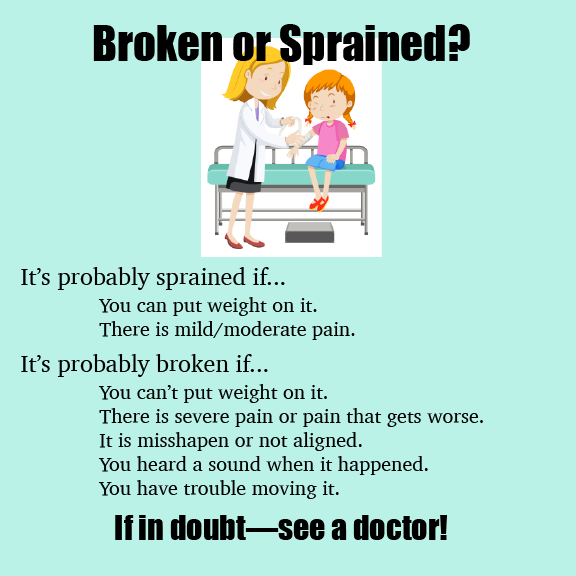
What’s the difference between a sprain and a fracture?
A sprain can be as painful as a break and can exhibit the same symptoms initially, so understanding what the difference is and how to treat each is important.
The tough, stretchy bands that hold your bones in place are called ligaments. They stretch and move, giving flexibility to your joints. When they get torn or stretch beyond their limits, what results is called a sprain.
A fracture, on the other hand, is a broken bone.

Why is it hard to tell the difference?
Since the initial symptoms of both injuries are similar, it’s not always easy to tell the difference. Let’s take for instance an injured ankle. You step in a low spot in the grass and “turn” your ankle. You can’t put your weight on it, it’s tender to the touch, bruised and swollen. If you don’t know which injury you have sustained, you may not follow the right procedure to make sure you heal correctly.

So how do I tell which it is?
The only way to tell for sure is to have the injury x-rayed, and even then smaller fractures may be missed. That’s why your doctor may request an MRI or another scan to assess the ankle. But there are a few ways to identify which it might be.
- What did you hear? In severe sprains, you may hear a popping sound. A fracture may make a crack sound. Unfortunately, in either case there may not be any sound at all.
- What does it look like? Both injuries produce swelling, but if your ankle looks clearly wrong, it’s probably a break.
- Are you experiencing pain? You’ll definitely feel pain with a sprain, but a break may produce numbness or tingling.
- Where is the pain located? If it’s in the soft tissue, it’s most likely a sprain. Pain directly over the bone may indicate a fracture

How are they treated?
Treatment for sprains is much different than treatment for a fracture. Most sprains will heal on their own. You may want to try the RICE method of treatment for a sprain. R stands for rest. I stands for ice. C for compression and E for elevation (above the level of your heart. If you stay off the sprain and take anti-inflammatories, the sprain will heal relatively rapidly. If it doesn’t, there may be a small fracture which your doctor can find with an x-ray or MRI.
Fractures require a lot more treatment, depending on the severity of the fracture. The ankle will need to be immobilized, perhaps needing a cast or a brace or boot. If the bones are misaligned, the doctor will realign them before immobilizing your ankle. In some cases, surgery may be needed to make sure the bones stay in place while they are healing. Pain relievers or anti-inflammatories may be prescribed.

How long will I be “down”?
Recovery times are different for sprains and breaks. A sprain may heal in a few days or sometimes a bit longer if it is a particularly bad sprain. A fracture, on the other hand, can take weeks or even months to heal. Most sprains don’t require physical therapy but most breaks do.
If you have sustained an injury and you are not sure about whether it is a break or sprain, by all means, see your doctor or an ER/urgent care center like at America’s ER Medical Centers.



